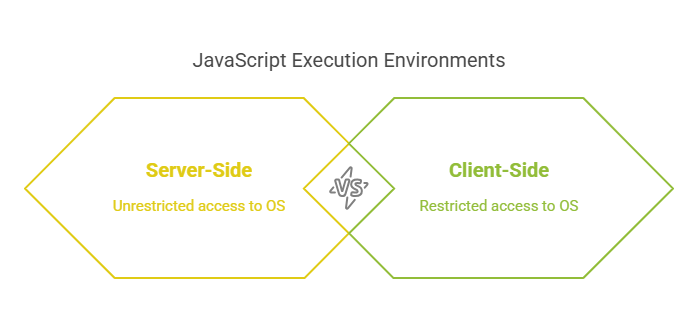Server Side vs Client Side JavaScript
JavaScript is popular for web development. Server and client programs can use it. It is essential to web development to comprehend the differences between these two ecosystems.

Client-side JavaScript
Client-side Code that executes directly in a user’s web browser is known as JavaScript. This is the most typical location for JavaScript, because it is the original purpose of the language. To handle this code, web browsers come with a special JavaScript engine, often known as a “JavaScript virtual machine” or interpreter. These engines include SpiderMonkey in Firefox, V8 in Chrome, Opera, and Edge, and JavaScript Core, Nitro, and SquirrelFish for Safari.
Client-side JavaScript is mostly used to make HTML pages more interactive. It makes dynamic user interfaces possible. This is accomplished by granting the script authority over the browser itself, utilising its features, and modifying the layout and content of online pages. JavaScript on the client side may read and write HTML elements, alter their styles, and change their content. It has the ability to respond to keystrokes, mouse clicks, and pointer movements.
The Browser Object Model (BOM) and the Document Object Model (DOM) aid in communication between your JavaScript code and the browser. To manipulate document content, you must first access the Document object, which is the window’s content and can be obtained through the document property of the Window object. Client-side JavaScript applications usually run in two stages: an event-handling phase that is asynchronous and event-driven, reacting to user input, network activity, or other events, and a script-execution phase where scripts are executed in order after loading the document. The browser’s JavaScript is single-threaded, so event handlers and scripts run separately. This makes programming easier by eliminating issues like race situations.
JavaScript code can be embedded in HTML documents in several ways, including inline within <script> tags, from an external file specified by the src attribute, in HTML event handler attributes (like onclick), or in javascript: URLs. A programming philosophy known as unobtrusive JavaScript advocates for keeping HTML (content) and JavaScript (behavior) separate, recommending the use of <script> elements with src attributes.
In-browser JavaScript’s capabilities are restricted for user security purposes in order to stop bad websites from gaining access to sensitive data or damaging user information. JavaScript on a webpage, for example, lacks direct access to OS functionalities and is unable to read/write specific files on the hard drive, copy them, or run applications.
“Same Origin Policy” refers to the restriction that JavaScript from one page often cannot access another page if they originate from separate sites (different domain, protocol, or port). In order to get around this, pages from various origins must agree and have proper JavaScript code in order to interchange data. The current page’s server can be reached by client-side JavaScript, but it is unable to receive data from other websites without express consent such as CORS (Cross-Origin Resource Sharing).
Historically, differing implementations and the slow adoption of new features have made it difficult to write complex client-side JavaScript that functions properly across browsers. On the other hand, newer browsers follow standards more closely, which reduces incompatibility. Developers employ techniques such as feature testing (capability testing), polyfills (code to provide missing feature support), transpilers (converting modern code to older versions), globally supported features, and libraries/frameworks like jQuery, which offered a compatible API across many browsers, including older ones like IE6.
Server-Side JavaScript
An application’s server side is the backend logic that usually operates on data centre machines. A server, not the user’s device, is where this code runs. A database is often used in its interactions.
Writing this backend code can be done with JavaScript in environments such as Node.js. With the help of Node.js, JavaScript programs may access the full operating system, facilitating operations such as file reading and writing, network data transmission and reception, and HTTP request creation and fulfilment. In comparison, the client-side JavaScript environment is less secure. When developing utility scripts and building web servers, Node.js is a popular option.
APIs and Frontend-Backend Communication
Websites need a backend for “interesting stuff,” like validating users when they log in. Frontend-backend communication is critical. APIs frequently handle this. When a request is made (for example, by using a URL), a piece of code on the server is triggered by the request and responds. An API functions as an interface for code.
Using client-side JavaScript, the DOM, HTML, and the XMLHttpRequest object, AJAX (Asynchronous JavaScript + XML) allows that portions of a webpage can be refreshed with real-time data from the server without requiring a page reload. An important breakthrough that made asynchronous communication with a server possible was this one. Use the XMLHttpRequest object to request URL data without reloading the page.
Since JSON is more user-friendly in JavaScript than XML, it has become the standard data format for AJAX applications. WebSockets are a contemporary alternative or comparable approach that facilitates bidirectional socket-type connections between client-side code and specialised servers, simplifying some networking operations.
JavaScript’s Wide Scope
The interactive components on almost all websites are powered by JavaScript, which is essential to web development. It’s everywhere online since it works in all major browsers. JavaScript can now be utilised outside the browser using Node.js. Full-stack development is possible with JavaScript, which can write frontend and backend code.
